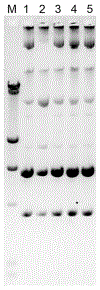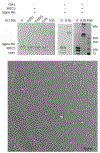Purification and Characterization of Human DNA Ligase IIIα Complexes After Expression in Insect Cells
- PMID: 35290642
- PMCID: PMC9278544
- DOI: 10.1007/978-1-0716-2063-2_15
Purification and Characterization of Human DNA Ligase IIIα Complexes After Expression in Insect Cells
Abstract
With improvements in biophysical approaches, there is growing interest in characterizing large, flexible multi-protein complexes. The use of recombinant baculoviruses to express heterologous genes in cultured insect cells has advantages for the expression of human protein complexes because of the ease of co-expressing multiple proteins in insect cells and the presence of a conserved post-translational machinery that introduces many of the same modifications found in human cells. Here we describe the preparation of recombinant baculoviruses expressing DNA ligase IIIα, XRCC1, and TDP1, their subsequent co-expression in cultured insect cells, the purification of complexes containing DNA ligase IIIα from insect cell lysates, and their characterization by multi-angle light scattering linked to size exclusion chromatography and negative stain electron microscopy.
Keywords: Affinity chromatography; Bacmid; Baculovirus; Insect cells; Ion exchange chromatography; Multiple angle light scattering; Negative stain electron microscopy; Size exclusion chromatography.
© 2022. The Author(s), under exclusive license to Springer Science+Business Media, LLC, part of Springer Nature.
Figures







References
-
- Hammel M, Yu Y, Mahaney BL, Cai B, Ye R, Phipps BM, Rambo RP, Hura GL, Pelikan M, So S, Abolfath RM, Chen DJ, Lees-Miller SP, Tainer JA (2010) Ku and DNA-dependent protein kinase dynamic conformations and assembly regulate DNA binding and the initial non-homologous end joining complex. J Biol Chem 285:1414–1423 - PMC - PubMed
-
- Hammel M, Yu Y, Radhakrishnan SK, Chokshi C, Tsai MS, Matsumoto Y, Kuzdovich M, Remesh SG, Fang S, Tomkinson AE, Lees-Miller SP, Tainer JA (2016) An intrinsically disordered APLF links Ku, DNA-PKcs, and XRCC4-DNA ligase IV in an extended flexible non-homologous end joining complex. J Biol Chem 291:26987–27006 - PMC - PubMed
-
- Hammel M, Rashid I, Sverzhinsky A, Pourfarjam Y, Tsai MS, Ellenberger T, Pascal JM, Kim IK, Tainer JA, Tomkinson AE (2021) An atypical BRCT-BRCT interaction with the XRCC1 scaffold protein compacts human DNA ligase IIIalpha within a flexible DNA repair complex. Nucleic Acids Res 49:306–321 - PMC - PubMed

